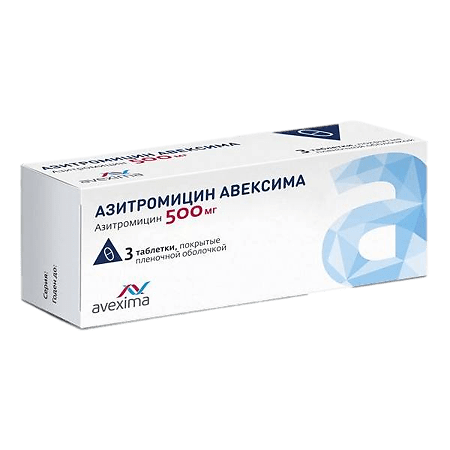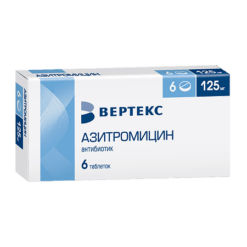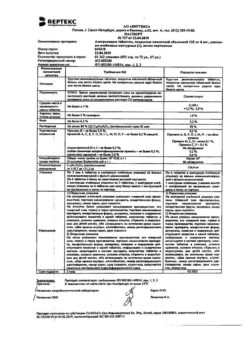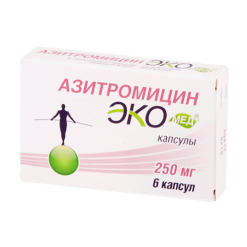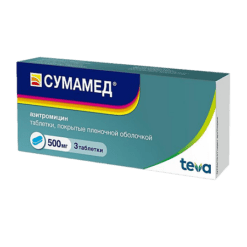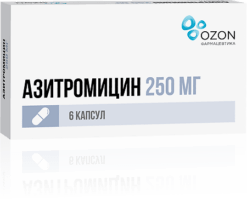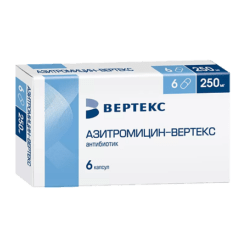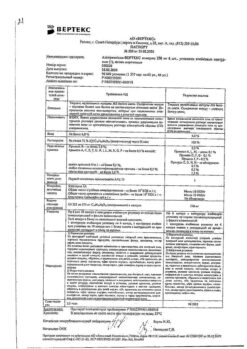No products in the cart.
Azithromycin Avexima, 500 mg 3 pcs
€1.00
Out of stock
(E-mail when Stock is available)
Description
Pharmacotherapeutic group: Azalid antibiotic
Pharmacodynamics
Azithromycin is a broad-spectrum bacteriostatic antibiotic of macrolide-azalid group. It has a broad spectrum of antimicrobial action. Azithromycin mechanism of action is associated with inhibition of microbial cell protein synthesis. Binding to 50S-subunit of ribosome, it inhibits peptide translocase at the translation stage and inhibits protein synthesis, slowing down the growth and reproduction of bacteria. In high concentrations it has a bactericidal effect. Microorganisms may be resistant to antibiotic action initially or may acquire resistance to it.
In most cases azithromycin susceptible:
- aerobic gram-positive microorganisms: Staphylococcus aureus
- (methicillin-sensitive), Streptococcus pneumoniae (penicillin-sensitive), Streptococcus pyogenes
- aerobic gram-negative microorganisms: Haemophilus influenzae, Haemophilus parainfluenzae, Legionella pneumophila, Moraxella catarrhalis, Pasteurella multocida, Neisseria gonorrhoeae
- anaerobic microorganisms: Clostridium perfringens, Fusobacterium spp., Prevotella spp, Porphyromonas spp.
- other microorganisms: Chlamydia trachomatis, Chlamydia pneumoniae, Chlamydia psittaci, Mycoplasma pneumoniae, Mycoplasma hominis, Borrelia burgdorferi
Microorganisms that can develop resistance to azithromycin:
- Streptococcus pneumoniae (penicillin-resistant).
Microorganisms initially resistant to azithromycin:
- aerobic gram-positive microorganisms: Enterococcus faecalis, Staphylococcus spp. (methicillin-resistant Staphylococcus spp. have a very high incidence of acquired resistance to macrolides);
- grypositive bacteria resistant to erythromycin;
- anaerobes: Bacteroides fragilis.
Pharmacokinetics
Absorption.
After oral administration, azithromycin is well absorbed and rapidly distributed in the body. After a single administration of 500 mg: bioavailability – 37% (effect of “primary passage” through the liver) maximum concentration (Cmax) (04 mg/l) in plasma is reached after 2-3 hours.
Distribution.
The apparent volume of distribution is 311 l/kg The binding to plasma proteins is inversely proportional to serum concentration and is 7-50%. It penetrates through cell membranes (effective in infections caused by intracellular pathogens). It is transported by phagocytes to the site of infection where it is released in the presence of bacteria. It easily passes through the histohematic barriers and enters the tissues. Concentration in tissues and cells is 10-50 times higher than in blood plasma. In infection nidus it is 24-34% higher than in healthy tissue.
Metabolism. Azithromycin is demethylated in the liver losing activity.
Excretion. Azithromycin has a very long half-life of 35-50 hours. Tissue elimination half-life is much longer.
The therapeutic concentration of azithromycin remains up to 5-7 days after the last dose. Azithromycin is excreted mainly unchanged – 50% through the intestine and 6% by the kidneys.
Indications
Indications
Infectious inflammatory diseases caused by microorganisms sensitive to azithromycin:
Active ingredient
Active ingredient
Composition
Composition
How to take, the dosage
How to take, the dosage
The drug is taken orally 1 time per day 1 hour before or 2 hours after the meal, without chewing.
Adults and children over 12 years old with body weight over 45 kg
In infections of the upper and lower respiratory tract, ENT-organ, skin and soft tissue (except for chronic erythema migrans) – 500 mg/day at a single dose for 3 days (course dose – 1.5 g).5 g).
In moderate acne – 500 mg once a day for 3 days, then 500 mg once a week for 9 weeks; the course dose – 6 g. The first weekly dose should be taken 7 days after the first daily dose (8th day from the start of treatment). The next 8 weekly doses should be taken 7 days apart.
In acute infections of the urogenital organs (uncomplicated urethritis or cervicitis) – 1 g once.
In Lyme disease (borreliosis) during the treatment of stage I (erythema migrans) – 1 g on the 1st day and from the 2nd through the 5th day – 500 mg daily (course dose – 3 g).
The same doses as for adults are used for treatment of elderly patients aged over 65 years. As this category of patients may have proarrhythmogenic factors, special attention should be paid to a possibility of arrhythmia and ventricular tachycardia of “pirouette” type.
In renal dysfunction (CK over 40 ml/min) the dose adjustment is not required.
Interaction
Interaction
Antacids
The antacids do not influence bioavailability of azithromycin, but decrease Cmax in plasma by 30%; therefore, the drug azithromycin should be taken at least 1 hour before or 2 hours after taking antacids and food.
Cetirizine
Concomitant use of azithromycin with cetirizine (20 mg) for 5 days in healthy volunteers did not result in pharmacokinetic interaction or significant QT interval changes.
Didanosine (didezoxinosine)
The concomitant use of azithromycin (1200 mg/day) and didanosine (400 mg/day) in 6 HIV-infected patients showed no change in the pharmacokinetic parameters of didanosine compared with the placebo group.
Digoxin (P-glycoprotein substrates)
Concomitant use of macrolide antibiotics including azithromycin with P-glycoprotein substrates such as digoxin leads to increased serum P-glycoprotein substrate concentration. Thus, when concomitant use of azithromycin and digoxin it is necessary to consider the possibility of increasing the concentration of digoxin in blood serum.
Zidovudine
The concomitant use of azithromycin (single administration of 1000 mg and multiple administration of 1200 mg or 600 mg) has little effect on the pharmacokinetics including renal excretion of zidovudine or its glucuronide metabolite. However, azithromycin administration caused an increase in the concentration of phosphorylated zidovudine clinically active metabolite in peripheral blood mononuclear cells. The clinical significance of this fact is unclear.
According to the theoretical possibility of ergotism, concomitant use of azithromycin with ergot alkaloid derivatives is not recommended.
Drugs metabolized with cytochrome P450 isoenzymes Azithromycin has little interaction with cytochrome P450 isoenzymes. Azithromycin has not been found to be involved in pharmacokinetic interactions similar to those with erythromycin and other macrolides. Azithromycin is neither an inhibitor nor an inducer of cytochrome P450 isoenzymes.
Pharmacokinetic studies have been conducted on the concomitant use of azithromycin and drugs metabolized by cytochrome P450 isoenzymes.
Atorvastatin
Concomitant administration of atorvastatin (10 mg daily) and azithromycin (500 mg daily) did not change concentration of atorvastatin in blood (on the basis of HMG-CoA reductase inhibition test). However, in post-registration period there were separate reports about cases of rhabdomyolysis in patients receiving azithromycin and statins concomitantly.
Carbamazepine
Pharmacokinetic studies with healthy volunteers showed no significant effect on plasma concentrations of carbamazepine and its active metabolite in patients receiving azithromycin concomitantly.
Cimetidine
In pharmacokinetic studies of the effect of a single dose of cimetidine on the pharmacokinetics of azithromycin no changes in the pharmacokinetics of azithromycin were found if cimetidine was used 2 hours before administration of azithromycin.
Indirect anticoagulants (coumarin derivatives)
In pharmacokinetic studies azithromycin had no effect on the anticoagulant effect of a single dose of 15 mg warfarin taken by healthy volunteers. Potentiation of anticoagulant effect has been reported after concomitant use of azithromycin and indirect anticoagulants (coumarin derivatives). Despite the fact that the causal relationship has not been established, frequent prothrombin time monitoring should be considered when using azithromycin in patients receiving oral anticoagulants (coumarin derivatives).
Cyclosporine
. In a pharmacokinetic study with healthy volunteers who received oral azithromycin (500 mg/day once daily) for 3 days and then cyclosporine (10 mg/kg/day once daily) a significant increase in Cmax and area under the “concentration-time” curve from 0 to 5 hours (AUC0-5) of cyclosporine in plasma was found. Caution should be exercised when concomitant use of these drugs. In case of necessity of concomitant use of these drugs it is necessary to monitor plasma concentrations of cyclosporine and adjust the dose accordingly.
Efavirenz
The concomitant use of azithromycin (600 mg/day once daily) and efavirenz (400 mg/day) daily for 7 days did not cause any clinically significant pharmacokinetic interaction.
Fluconazole
The simultaneous use of azithromycin (1200 mg once daily) did not change pharmacokinetics of fluconazole (800 mg once daily). Total exposure and half-life of azithromycin did not change with fluconazole concomitant administration, but there was an 18% reduction in plasma Cmax of azithromycin, which was not clinically relevant.
Indinavir
The concomitant use of azithromycin (1200 mg once daily) had no statistically significant effect on the pharmacokinetics of indinavir (800 mg 3 times daily for 5 days).
Methylprednisolone
Asithromycin has no significant effect on the pharmacokinetics of methylprednisolone.
Nelfinavir
The simultaneous use of azithromycin (1200 mg) and nelfinavir (750 mg 3 times daily) causes increased equilibrium concentration of azithromycin in serum. No clinically significant adverse effects have been observed and no dose adjustment of azithromycin is required when used concomitantly with nelfinavir.
Rifabutin
The concomitant use of azithromycin and rifabutin has no effect on the serum concentrations of either drug. Neutropenia has sometimes been observed with concomitant use of azithromycin and rifabutin. Although neutropenia has been associated with the use of rifabutin, a causal relationship between the use of a combination of azithromycin and rifabutin and neutropenia has not been established.
Sildenafil
When used in healthy volunteers, there is no evidence of an effect of azithromycin (500 mg/day daily for 3 days) on the AUC and Cmax of sildenafil or its major circulating metabolite in plasma.
Terfenadine
There has been no evidence of interaction between azithromycin and terfenadine in pharmacokinetic studies. There have been isolated cases where the possibility of such an interaction could not be ruled out completely, but there has not been any concrete evidence that this interaction has occurred. It has been found that concomitant use of terfenadine and macrolides can cause arrhythmias and prolongation of the QT interval.
Theophylline
No interaction between azithromycin and theophylline has been identified.
Triazolam/midazolam
There are no significant changes in pharmacokinetic parameters when azithromycin is used concomitantly with triazolam or midazolam in therapeutic doses.
Trimethoprim/sulfamethoxazole
The concomitant use of trimethoprim/sulfamethoxazole with azithromycin showed no significant effect on plasma total exposure or renal excretion of trimethoprim or sulfamethoxazole. Serum azithromycin concentrations were consistent with detectable concentrations in other studies.
Special Instructions
Special Instructions
If one dose of azithromycin is missed, the missed dose should be taken as soon as possible and the next ones should be taken 24 hours apart.
Asithromycin should be taken at least 1 hour before or 2 hours after taking antacid medications.
Azithromycin should be used with caution in patients with mild to moderate hepatic impairment because of the possibility of fulminant hepatitis and severe hepatic impairment. In case of symptoms of liver dysfunction such as rapidly increasing asthenia jaundice darkened urine bleeding tendency hepatic encephalopathy azithromycin therapy should be discontinued and liver function tests should be performed.
In patients with impaired renal function: In patients with a GFR of 10-80 ml/min, no dose adjustment is required for azithromycin therapy should be performed with caution under monitoring of renal function status.
As with other antibacterial agents during therapy with azithromycin, patients should be regularly examined for the presence of non-susceptible microorganisms and signs of superinfections, including fungal ones. Azithromycin should not be used for longer courses than directed, since the pharmacological properties of azithromycin suggest a short and simple dosing regimen.
There are no data on possible interaction between azithromycin and derivatives of ergotamine and dihydroergotamine, but because of the development of ergotism when using macrolides with derivatives of ergotamine and dihydroergotamine simultaneously, this combination is not recommended.
Long-term use of azithromycin may result in pseudomembranous colitis caused by Clostridium difficile in the form of both mild diarrhea and severe colitis.
In case of antibiotic-associated diarrhea during treatment with azithromycin and 2 months after discontinuation of therapy, clostridial pseudomembranous colitis should be excluded. Drugs inhibiting intestinal peristalsis are contraindicated.
In treatment with macrolides including azithromycin prolongation of cardiac repolarization and QT interval have been observed to increase the risk of cardiac arrhythmias including pirouette arrhythmias.
. Caution should be exercised when using azithromycin in patients with the presence of proarrhythmogenic factors (especially in elderly patients) including congenital or acquired prolongation of QT interval in patients taking antiarrhythmic Class IA drugs (quinidine procainamide) III (dofetilide amiodarone and sotalol) cisapride terfenadine antipsychotic drugs (pimozide) antidepressants (citalopram) fluoroquinolones (moxifloxacin and levofloxacin) in patients with disorders of water and electrolyteelectrolyte balance especially in cases of hypokalemia or hypomagnesemia with clinically significant bradycardia, cardiac arrhythmia or severe heart failure.
The use of azithromycin may provoke myasthenic syndrome or worsen myasthenia gravis.
The effect on the ability to drive:
With the development of adverse effects on the nervous system and the visual system, caution should be exercised when performing activities requiring increased concentration and rapid psychomotor reactions.
Contraindications
Contraindications
With caution
Side effects
Side effects
Infectious diseases: infrequent – candidiasis (including oral and genital mucosa), pneumonia, pharyngitis, gastroenteritis, respiratory diseases, rhinitis; unknown frequency – pseudomembranous colitis.
Overdose
Overdose
Symptoms: Nausea, temporary hearing loss, vomiting, diarrhea.
Treatment: Symptomatic.
Pregnancy use
Pregnancy use
Pregnancy
Similarities
Similarities
Additional information
| Manufacturer | Irbit Chemical Plant, Russia |
|---|---|
| Medication form | pills |
| Brand | Irbit Chemical Plant |
Other forms…
Related products
Buy Azithromycin Avexima, 500 mg 3 pcs with delivery to USA, UK, Europe and over 120 other countries.

